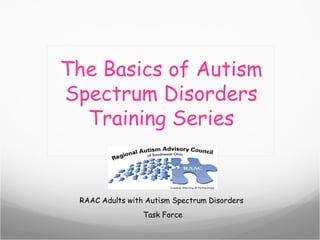Adults with autism training module five v2
•Transferir como PPT, PDF•
1 gostou•470 visualizações
Denunciar
Compartilhar
Denunciar
Compartilhar

Recomendados
Recomendados
Mais conteúdo relacionado
Destaque
Destaque (15)
Hodnocení vědy na Univerzitě Karlově v Praze / Helena Kvačková

Hodnocení vědy na Univerzitě Karlově v Praze / Helena Kvačková
Parametric studies of the effectiveness of NO oxidation process by ozone

Parametric studies of the effectiveness of NO oxidation process by ozone
Canyon corridor boundaries and population by tract aubrey relf

Canyon corridor boundaries and population by tract aubrey relf
Semelhante a Adults with autism training module five v2
NCompass Live
http://nlc.nebraska.gov/ncompasslive/Effective Interaction: Communicating With and About People with Disabilities ...

Effective Interaction: Communicating With and About People with Disabilities ...Nebraska Library Commission
Semelhante a Adults with autism training module five v2 (20)
School training module nine, communication and autism

School training module nine, communication and autism
Adults with autism training series module three v2

Adults with autism training series module three v2
Effective Interaction: Communicating With and About People with Disabilities ...

Effective Interaction: Communicating With and About People with Disabilities ...
How to communicate with individuals with special needs

How to communicate with individuals with special needs
How to communicate with and about individuals with special needs

How to communicate with and about individuals with special needs
Mais de sworaac
Mais de sworaac (20)
Adults with autism training series module one v2 _2

Adults with autism training series module one v2 _2
School training module two,physical characteristics of autis

School training module two,physical characteristics of autis
School training module twenty, asperger syndrome managing and organizing the env

School training module twenty, asperger syndrome managing and organizing the env
School training module twelve,understanding behavior in stud

School training module twelve,understanding behavior in stud
School training module fourteen,functional behavior assessme

School training module fourteen,functional behavior assessme
School training module three,cognition and learning in autis

School training module three,cognition and learning in autis
School training module thirteen, social skills. (2)

School training module thirteen, social skills. (2)
School training module ten, communication in the classroom

School training module ten, communication in the classroom
School training module six, using reinforcement in the classr

School training module six, using reinforcement in the classr
School training module seventeen special issues of adolescenc

School training module seventeen special issues of adolescenc
Adults with autism training module five v2
- 1. The Basics of Autism Spectrum Disorders Training Series RAAC Adults with Autism Spectrum Disorders Task Force
- 2. Adult Training Series Modules Module One: Autism Defined, Autism Prevalence and Primary Characteristics Module Two: Physical Characteristics of Autism Module Three: Cognition and Learning in Autism Module Four: Autism and Sensory Differences Module Five: Communication and Autism
- 3. Adult Training Series Modules Module Six: Behavior Challenges and Autism Module Seven: Understanding Behavior in Persons with Autism Module Eight: Functional Behavior Assessment Module Nine: Autism and Leisure Skills to Teach Module Ten: Special Issues of Adolescence and Adulthood Module Eleven: Safety and Autism
- 4. Big Idea Communication may be very difficult for someone with ASD.
- 5. Communication Some people with ASD do not talk They may use sign language to communicate. They may use pictures to communicate. They may use a device that talks for them. Some people with ASD talk but are hard to understand. They may get upset if you don’t understand them.
- 6. Communication Some folks with ASD may repeat what you say. If you say, “do you want juice,” they may repeat what you said. This is called Echolalia. This may be their way of saying yes. It might mean that they did not understand what you said. It may happen more often when the person is nervous or upset.
- 7. Communication Some people with ASD have a hard time making choices. Some people say “yes” to almost every choice you give them, even if they don’t want it. Some people say “no” to almost every choice you give them, even if they want it. Some people almost always choose the last thing you said to them. For example: if you say, “do you want crackers or cookies,” they may say “cookies” even when they want crackers.
- 8. Big Idea For people who have difficulty making choices, we need to help them by showing them pictures, drawings, logos or the actual items.
- 9. Communication Just because the person can say something, it doesn’t always mean they understand what they are saying. Just because the person with ASD has done something before, doesn’t mean that they will be able to understand what is going to happen the next time. People with ASD usually need pictures to help them understand what is going to happen.
- 10. Communication Some people with ASD have trouble understanding certain words time words such as “later,” “tomorrow,” “after while.” feeling words such as “share” or “be nice.” sayings such as “shake a leg.” slang words such as “cool.” We have to “watch our language” and make sure the person understands what we are saying.
- 11. Communication Tips • Use visuals – such as pictures to help the person understand. • Say things using simple words. • Don’t talk too fast. • Never talk about behaviors with the person while they are upset. • Never talk about the person with ASD to someone else, as if the person weren’t there or as if they can’t understand what you are saying.
- 12. Big Idea We could be the communication problem. We need to watch what we say and how we say it.
Notas do Editor
- Check bullets